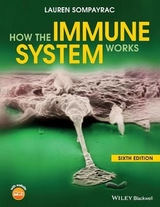
How the Immune System Works
John Wiley & Sons Inc (Verlag)
978-1-118-99777-2 (ISBN)
- Titel ist leider vergriffen;
keine Neuauflage - Artikel merken
How the Immune System Works has helped thousands of students understand what s in their big, thick, immunology textbooks. In his book, Dr. Sompayrac cuts through the jargon and details to reveal, in simple language, the essence of this complex subject. In fifteen easy-to-read chapters, featuring the humorous style and engaging analogies developed by Dr. Sompayrac, How the Immune System Works explains how the immune system players work together to protect us from disease and, most importantly, why they do it this way. Rigorously updated for this fifth edition, How the Immune System Works includes the latest information on subjects such as vaccines, the immunology of AIDS, and cancer. A highlight of this edition is a new chapter on the intestinal immune system currently one of the hottest topics in immunology. Whether you are completely new to immunology, or require a refresher, How the Immune System Works will provide you with a clear and engaging overview of this fascinating subject. But don t take our word for it! Read what students have been saying about this classic book: "What an exceptional book! It's clear you are in the hands of an expert."
"Possibly the Best Small Text of All Time!" "This is a FUN book, and Lauren Sompayrac does a fantastic job of explaining the immune system using words that normal people can understand." "Hands down the best immunology book I have read...a very enjoyable read." "This is simply one of the best medical textbooks that I have ever read. Clear diagrams coupled with highly readable text make this whole subject easily understandable and engaging." Now with a brand new website at www.wiley.com/go/sompayrac featuring Powerpoint files of the images from the book
Lauren Sompayrac is Professor Emeritus, University of Colorado, Boulder, USA.
Acknowledgments, vii How to Use This Book, viii This book is neither a comprehensive text nor an exam-review tool. It is an overview of the immune system, designed to give anyone who is learning immunology a feel for how the system fits together. Lecture 1 An Overview, 1 The immune system is a team effort, involving many different players who work together to provide a powerful defense against invaders. Focusing in on one player at a time makes it hard to understand the game. Here we view the action from the grandstands to get a wide-angle picture of what the immune system is all about. Lecture 2 The Innate Immune System, 13 The innate immune system is a hard-wired defense that has evolved over millions of years to recognize pathogens that commonly infect humans. It provides a rapid and powerful response against everyday invaders. Lecture 3 B Cells and Antibodies, 27 B cells and the antibodies they produce are part of the adaptive immune system. This defense evolves during our own lifetime to protect us against invaders that we, personally, have never encountered before. Lecture 4 The Magic of Antigen Presentation, 42 T cells, another weapon of the adaptive immune system, only recognize invaders which are properly presented by specialized antigen presenting cells. This feature keeps these important cells focused on the particular attackers which they are able to defend against. Lecture 5 T Cell Activation, 55 Before they can spring into action, T cells must be activated. This requirement helps insure that only useful weapons will be mobilized. Lecture 6 T Cells at Work, 63 Once they have been activated, helper T cells orchestrate the immune response, and killer T cells destroy infected cells. Lecture 7 Secondary Lymphoid Organs and Lymphocyte Trafficking, 72 B and T lymphocytes travel through secondary lymphoid organs looking for the intruders they can defend against. Once activated in the secondary lymphoid organs, B and T cells are dispatched to the particular areas of the body where they can be most useful. Lecture 8 Restraining the Immune System, 84 The powerful weapons of the immune system must be restrained lest they become overexuberant. In addition, once an invader has been defeated, the immune system must be reset to prepare for future attacks. Lecture 9 Self Tolerance and MHC Restriction, 88 T cells must be trained to focus on appropriately presented invaders, and B and T lymphocytes must learn not to attack our own bodies. Lecture 10 Immunological Memory, 98 The innate immune system remembers pathogens which have been attacking humans for millions of years. In contrast, B and T cells remember pathogens we have encountered during our lifetime. Memory B and T lymphocytes respond more quickly and effectively to a subsequent attack by the same invader. Lecture 11 The Intestinal Immune System, 103 The human intestines are home to trillions of bacteria, viruses, fungi, and parasites. How the immune system deals with these potentially dangerous intestinal residents, which frequently invade the tissues surrounding the intestines, is a hot topic in immunology. Lecture 12 Vaccines, 110 Vaccines safely mimic the attack of an invader so that our immune system will be primed and ready for a future challenge by the same invader. Lecture 13 The Immune System Gone Wrong, 116 The immune system generally does a good job of defending us without causing a lot of collateral damage. Sometimes, however, mistakes are made. Lecture 14 Immunodeficiency, 126 Serious disease may result when our immune system does not operate at full strength. Humans who are infected with the AIDS virus have profoundly impaired immune systems. Lecture 15 Cancer and the Immune System, 131 The human immune system is not very good at defending us against cancer. Indeed, there is a built-in conflict between the need to minimize the chance that its weapons will attack our own bodies, and the need to destroy wannabe cancer cells. Glossary, 139 Here are definitions of some of the terms that immunologists use but which normal people wouldn t. List of Acronyms and Abbreviations, 142 Immunologists are big on acronyms and abbreviations, so I ve made a list to which you can refer. Index, 143
| Erscheint lt. Verlag | 26.10.2015 |
|---|---|
| Reihe/Serie | The How it Works Series |
| Verlagsort | New York |
| Sprache | englisch |
| Maße | 213 x 272 mm |
| Gewicht | 456 g |
| Themenwelt | Medizin / Pharmazie ► Medizinische Fachgebiete |
| Studium ► Querschnittsbereiche ► Infektiologie / Immunologie | |
| ISBN-10 | 1-118-99777-8 / 1118997778 |
| ISBN-13 | 978-1-118-99777-2 / 9781118997772 |
| Zustand | Neuware |
| Informationen gemäß Produktsicherheitsverordnung (GPSR) | |
| Haben Sie eine Frage zum Produkt? |
aus dem Bereich



